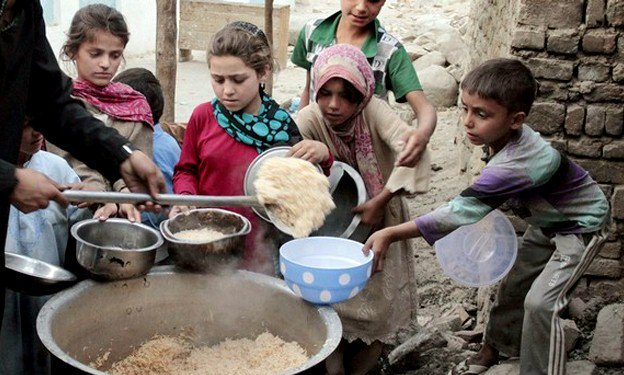Food crisis is one of the long lasting unsolved problems to impoverished countries including Afghanistan; globally, it takes the life of around 30,000 - 60,000 people each day. Over a quarter of Afghan children die before their fifth birthday mostly from preventable diseases such as pneumonia and diarrhea but the rest of them are suffering unprecedented malnourishment, stunting, underweight, mental retardation and vitamin deficiency. According to the recent report, 39% of Afghan people are living under poverty line. 78% of Afghan children lack access to safe water and 1 in 8 Afghan women die in childbirth. People in Afghanistan are using opium to block pain; the pain of hunger, joblessness, sickness, physical and mental trauma. As a result, nearly three million addicts in this nation of about 35 million people, including 60,000 children under age 15, and about 13 percent are women and 7 percent are children. Most of the women are opium addicts desperate to blunt the trauma of endless war. Many are illiterate mothers with unemployed husbands. Most have a little in the way of job skills, and some became addicts while picking opium poppies to earn a living and support their families…
Since the 2008 global food price crisis, food insecurity has raised to the top of many national and international policy agendas. Given the potential implications for poverty, health, and nutrition, and the outbreak of food riots, the impact of growing high food prices on food security is of concern to governments and aid organizations alike. These issues are particularly salient in conflict-afflicted countries where food production and distribution networks are strained and where distributing emergency food aid can be a challenge. The broader relationship between food insecurity and conflict is a complicated one. Much of the existing literature (and conventional wisdom) on the relationship between food insecurity and conflict suggests that food insecurity can be a consequence of conflict (i.e., due to the destruction of agricultural resources or the disruption of markets) and also can be a cause of conflict (i.e., through economic and social grievances). In these cases, this harmful cycle can result in chronic food insecurity and, more broadly, can exacerbate poverty.
After decades of external and internal conflicts, along with prolonged droughts, Afghanistan has one of the poorest, least well-nourished populations in the world. According to the National Nutrition Survey, approximately 60% of children under five suffered from chronic malnutrition (stunting) and 8% suffered from acute malnutrition (wasting). According to the National Risk and Vulnerability Assessment, nearly 30% of the Afghan populations do not meet minimum daily food requirements (2,100 kilocalories per person)
Due to a confluence of domestic (drought), regional, and international (food price crisis) factors, the price of basic food items such as wheat flour (the dietary staple) doubled. Such an economic shock could have serious implications for households in Afghanistan, many of whom are impoverished. And live in conflict-afflicted areas. We estimate the differential effects of wheat flour price increases on household food security – as measured by calorie intake and the real value of food consumed based on the level of conflict in the province where the household is located. That is, we test whether being located in a province with higher levels of conflict is associated with more or less pronounced price effects.
The factors of food crisis and poverty in Afghanistan include: high population rate (the population has almost doubled in the last two decade, from around 15 million to almost 35 million according to the World Bank), opium cultivation (the contribution of opium to formal economy is almost 50%, which has increased entitlement at a cost of low local food production and annual shortfalls), inflation (the fluctuation in prices has a significant impact on urban and rural population in terms of per capita consumption at both individual and household level), high dependency ratio (since a decent percentage of the population is between 0-25, a great majority of them are dependent on their siblings, parents or relatives for access to food, clothing and housing), lack of education and skills (Afghanistan has one of the lowest educated population in the world and in terms of skills ranks at 2/3 in major industries like mining, construction and few other on a scale of 12), security situation (Due to poor security situation, there has been an increase in homelessness, slums, internally displaced persons which has led to an increase in poverty and food insecurity), corruption and poor governance (Afghanistan has one of the highest corruption rates in the world, on average each professional regardless of his employment status take a bribe of at least 25% and some regions have corruption rate as high as 99%).
Home » Opinion » Unprecedented Food Crisis
Unprecedented Food Crisis
| Mohammad Zahir Akbari

